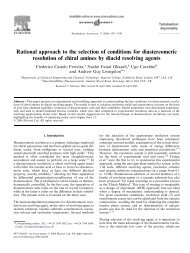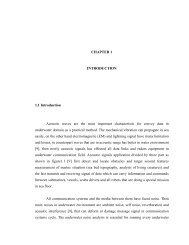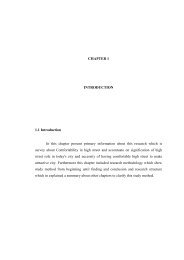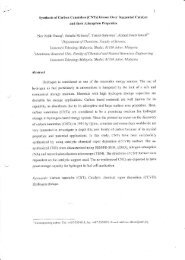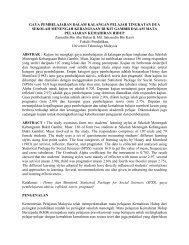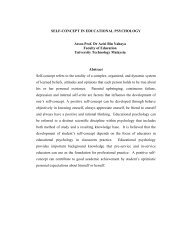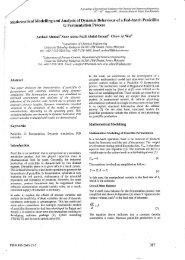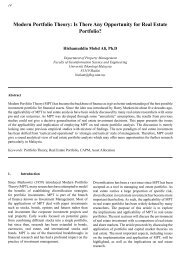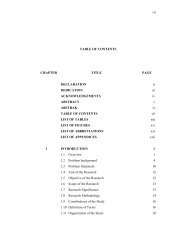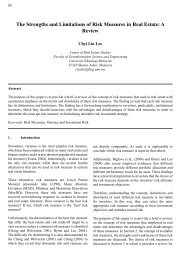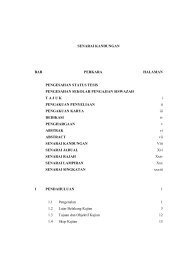Comparison of Signal-to-noise, Blank Determination, and - Universiti ...
Comparison of Signal-to-noise, Blank Determination, and - Universiti ...
Comparison of Signal-to-noise, Blank Determination, and - Universiti ...
Create successful ePaper yourself
Turn your PDF publications into a flip-book with our unique Google optimized e-Paper software.
<strong>Blank</strong> determination was carried out by analysis <strong>of</strong> 10 independent sample blanks, the mean<br />
concentration <strong>and</strong> the st<strong>and</strong>ard deviations <strong>of</strong> the blank results were calculated (Table 3).<br />
The blank determination method as described in EURACHEM guide (7) , LOD is<br />
estimated as 3s more than the blank value as it assumes that a signal more than 3 times above<br />
the st<strong>and</strong>ard deviation <strong>of</strong> the sample blank value is likely <strong>to</strong> have arisen from the measur<strong>and</strong>.<br />
For this approach, it needs a sample blank for each sample matrix <strong>to</strong> be analyzed, <strong>and</strong> the<br />
estimated LOD <strong>and</strong> LOQ may vary for different sample matrices. However, getting a true<br />
sample blank can be difficult <strong>and</strong> in certain situation, reagent blank is used as a blank. The<br />
LOD <strong>and</strong> LOQ estimated by using reagent blank does not take in<strong>to</strong> consideration <strong>of</strong> matrix<br />
interference, <strong>and</strong> the estimated values can be smaller than that using true sample blank.<br />
Linear Regression<br />
Linear ordinary least-squares regression parameters were calculated based on the analysis <strong>of</strong><br />
ten replicates <strong>of</strong> test compounds at seven different concentration levels. The data obtained<br />
were used <strong>to</strong> compute the two coefficient <strong>of</strong> the calibration curve <strong>and</strong> also <strong>to</strong> perform a lack<strong>of</strong>-fit<br />
test, which was used <strong>to</strong> verify that the selected calibration domain was actually linear.<br />
The st<strong>and</strong>ard deviation <strong>of</strong> the blank was estimated by using both st<strong>and</strong>ard deviation <strong>of</strong><br />
regression residual ( ) <strong>and</strong> y – intercept ( s ) as shown in Table 4 <strong>and</strong> results <strong>of</strong> the<br />
sres 0 y<br />
statistical evaluation <strong>of</strong> the linear regression curve is shown in Table 5.<br />
The calculation <strong>of</strong> the test table showed that the test for regression was significant while<br />
the F observed value for each analyte was much higher than the critical value <strong>of</strong> 3.993, which<br />
corresponded <strong>to</strong> F(1,69,5%). This meant that the instrumental response was significantly<br />
correlated <strong>to</strong> the analyte concentration. When the lack-<strong>of</strong>-fit test was performed, the Fisher<br />
variable associated <strong>to</strong> the test for the error <strong>of</strong> model was smaller than the critical value <strong>of</strong><br />
2.361. It can be concluded that the error <strong>of</strong> model was not significant at the risk level <strong>of</strong> 5%<br />
<strong>and</strong> the proposed linearity domain could be accepted.<br />
The linear regression method can help <strong>to</strong> solve the problem <strong>of</strong> difficulty in obtaining<br />
matrix blank for other methods. This is because calibration curve can be prepared by sample<br />
addition method. From this study, the results showed that the y-intercept st<strong>and</strong>ard deviation<br />
<strong>and</strong> y-residual st<strong>and</strong>ard deviation varied greatly. The values <strong>of</strong> y-intercept st<strong>and</strong>ard deviation<br />
were much lower than those <strong>of</strong> y-residual st<strong>and</strong>ard deviation for the five analytes. These<br />
results were in agreement with the study reported by Vial <strong>and</strong> Jardy (8). The values <strong>of</strong> LOD<br />
<strong>and</strong> LOQ obtained by this method can vary depending on the number <strong>of</strong> concentration levels,<br />
range <strong>of</strong> concentration used, number <strong>of</strong> measurement <strong>and</strong> data heteroscedasticity. The<br />
ordinary least-square regression is used in this case with the assumption that the data obtained<br />
are homoscedastic, if not; the weighted least-square regression is preferred.<br />
<strong>Comparison</strong> <strong>of</strong> LOD <strong>and</strong> LOQ by different methods<br />
Based on the experimental results, the LOD <strong>and</strong> LOQ were estimated for the different<br />
methods as summarized in Table 6 <strong>and</strong> Table 7.<br />
For LOD, the values obtained by signal-<strong>to</strong>-<strong>noise</strong> <strong>and</strong> blank determination methods were<br />
close <strong>to</strong> each other. The linear regression method by using s showed largest values <strong>of</strong> LOD<br />
<strong>and</strong> by using s gave lowest values <strong>of</strong> LOD for all the analytes. For LOQ, similar trend<br />
y<br />
0<br />
observed for linear regression method as in LOD. However, the signal-<strong>to</strong>-<strong>noise</strong> method<br />
presented about two times values <strong>of</strong> LOQ as compared <strong>to</strong> blank determination method. The<br />
LOQ values obtained by blank determination were comparable <strong>to</strong> linear regression method<br />
res<br />
5



